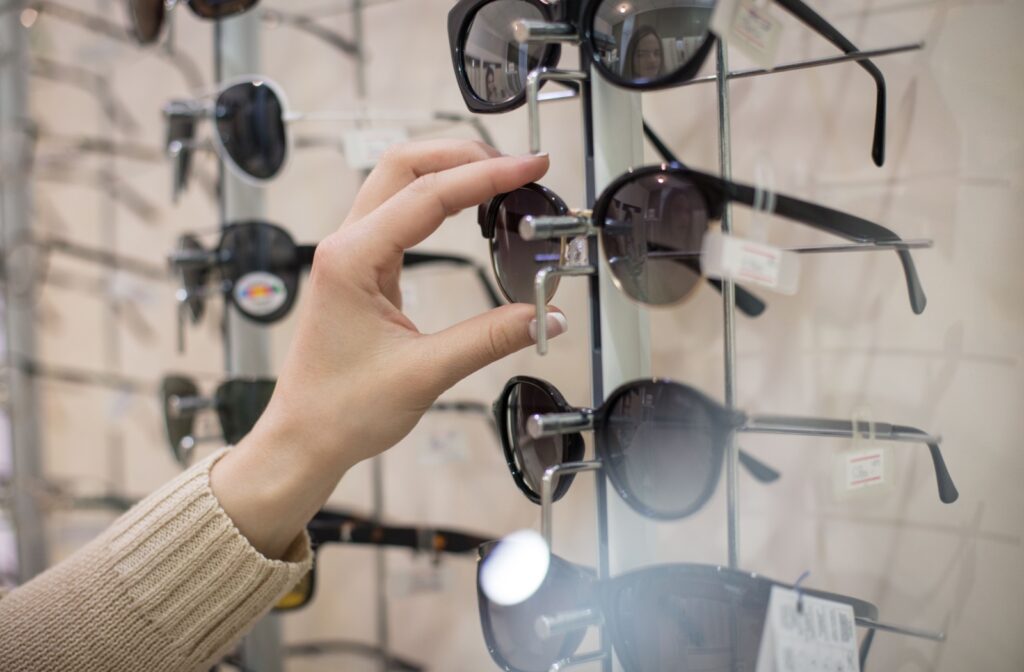You probably notice how the sun can lighten your hair or darken your skin after a day outdoors, but is the same true for your eyes?
Despite what you may have heard, the sun’s rays do not lighten your eye color and can actually cause the pigment in your irises to darken slightly over many years. More importantly, that same sunlight contains UV rays that can affect your long-term eye health.
Understanding this connection can help you take the right steps to protect your vision.
Sun Exposure & Your Eye Color
The pigment responsible for your skin, hair, and eye color is melanin. When your skin is exposed to the sun, it produces more melanin to protect itself, resulting in a tan. While your eyes also contain melanin, the process works a bit differently for your irises.
Melanin’s Role in Your Iris
The amount of melanin in the front layer of your iris determines your eye color. Brown eyes have a high concentration of melanin, while blue eyes have very little. Sun exposure doesn’t significantly change melanin content, so it won’t cause a noticeable shift in your base eye color.
Do Brown Eyes Get Lighter in the Sun?
Sunlight won’t lighten your brown eyes. You might notice flecks of gold or hazel that seem more prominent in bright light, but this is an illusion. Different lighting conditions can change how your eyes appear, but the actual pigment remains the same.
What Determines Your Eye Color
Your eye color is set by your genetics long before you ever step out into the sun. The genes you inherit from your parents control the amount of melanin your irises produce. This is typically established in early childhood and stays consistent throughout your life.
The Science of Blue & Green Eyes
If you have blue eyes, it’s because there is very little melanin in your iris. The blue hue comes from light scattering across the iris fibers—it’s actually similar to the process that results in the sky appearing blue!. Green and hazel eyes have a moderate amount of melanin, falling somewhere between blue and brown.
Can You Lighten Your Eyes Naturally?
There is no safe or effective way to change your eye color naturally. Any perceived changes in color are usually temporary and caused by your environment. These factors include:
- Lighting: Bright sunlight or dim indoor lighting can make your eyes seem like a different shade.
- Clothing & Makeup: Colors you wear can create a contrast that makes your eyes appear brighter or deeper.
- Pupil Size: In bright light, your pupils constrict, showing more of your iris and potentially altering its appearance.
Other Reasons Eye Color Can Change
While the sun is not a factor, your eye color can shift for other reasons. If you notice a significant or sudden change, an eye doctor in Riverside can help you understand the cause. These changes are often gradual and happen over long periods.
Changes From Infancy to Adulthood
Many infants are born with blue eyes that darken over their first few years as melanin develops. Later in life, some people find their eye color subtly fades. This is a slow, natural process as the pigment in the iris gradually lessens with age.
How Health Conditions & Medication Affect Eye Color
Certain health conditions and medications can also alter your eye color. Conditions like pigmentary glaucoma or Fuch’s heterochromic uveitis can affect melanin in the iris. These changes are uncommon, but nonetheless highlight the importance of regular eye health check-ups and proper disease management.
The Sun’s Impact on Eye Health
The sun’s ultraviolet (UV) rays pose a real risk to your eye health. This is especially true if you have lighter-colored eyes. The same melanin that gives your eyes their color also provides a layer of protection from the sun.
Why Light Eyes Have Higher UV Risks
Blue, green, and gray eyes have less protective melanin than brown eyes. This allows more damaging UV light to enter the eye and reach the delicate structures inside. Over time, this exposure can contribute to a higher risk of developing certain eye conditions.
Signs of UV Damage to the Eyes
Consistent sun exposure without proper protection can lead to discomfort and vision problems. Some common signs associated with UV damage include:
- Blurry vision
- A gritty or sandy feeling in the eyes
- Increased sensitivity to light
- Redness or watery eyes

How to Protect Your Eyes & Vision
You can easily take proactive steps to shield your eyes from the sun. Incorporating a few simple habits into your daily routine can support your vision for years to come. It’s all about creating a barrier between your eyes and harmful UV radiation.
Choose the Right Sunglasses
When you shop for a quality pair of sunglasses, look for a label that says they block 99% or 100% of UVA and UVB rays. Wraparound frames are a great option because they help block light from entering around the sides. This gives you more complete coverage and protection.
Add a Hat for Extra Protection
A wide-brimmed hat is an excellent companion to your sunglasses. Hats can block a significant amount of direct sunlight from reaching your face and eyes. This offers a powerful defense against UV exposure.
The Importance of Regular Eye Exams
Routine eye exams are a key part of maintaining your eye health. During a check-up, your eye doctor in Riverside can assess your vision and check for early signs of sun-related damage. This gives you an opportunity to ask questions and get personalized advice.
Protect Your Eye Health & Vision
Your eye health is a vital part of your overall well-being.
At Total Vision Riverside, we focus on a health-based approach to care that considers your unique lifestyle. Schedule a comprehensive eye exam with our team today to learn more about protecting your vision.



